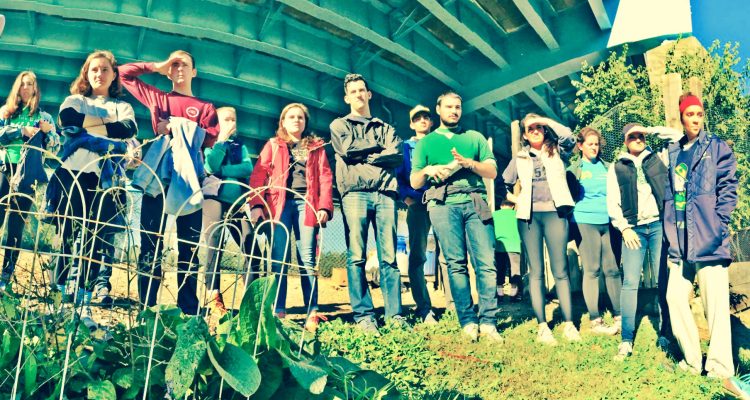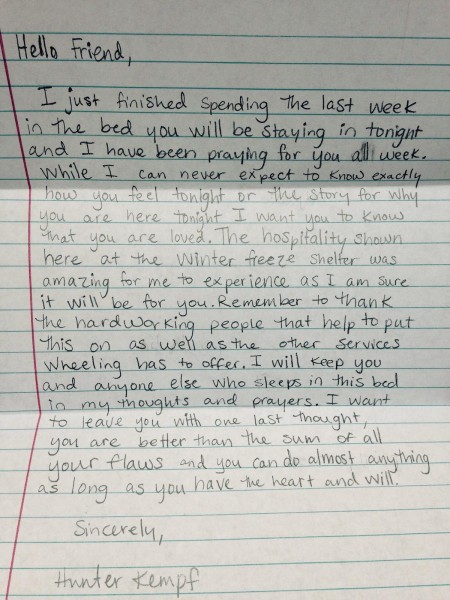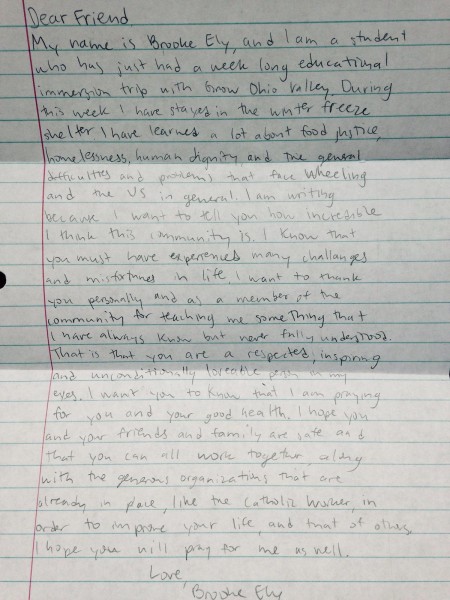Story courtesy of Weelunk partner West Virginia Public Broadcasting
A group of students from the University of Notre Dame just came to West Virginia for fall break. Instead of relaxing with friends as many college students do, these guys got a taste of life in a food desert.
They report it was surprisingly delicious, or it could be if there were a little more “food justice” in the world.
Listen to more of the story: HERE
One in seven people in West Virginia has trouble putting food on the table at some point in the year (~15 percent), according to data from the U.S. Census Bureau. Sometimes the problem is lack of money. Sometimes it’s access to good food. And many communities exist that are disproportionately affected.
A nonprofit called Grow Ohio Valley is working to help more people get access to healthy meals by growing food in abandoned lots in Wheeling. The organization is also trying to teach people about existing food disparities. One way organizers are getting ideas out is by inviting college students in for a “Food Justice Immersion Program.”
What is Food Justice?
The definition of food justice is often debated, but for many people it means the right for everyone to have access to plenty good and healthful foods. This idea was central to the immersion program the non-profit Grow Ohio Valley hosted in Wheeling.
FOOD JUSTICE is the right of communities everywhere to produce, process, distribute, access, and eat good food regardless of race, class, gender, ethnicity, citizenship, ability, religion, or community. Includes:
Freedom from exploitation
Ensures the rights of workers to fair labor practices
Values-based: respect, empathy, pluralism, valuing knowledge
Racial Justice: dismantling of racism and white privilege
Gender equity
(See more at: http://www.iatp.org/documents/draft-principles-of-food-justice#sthash.iBMx87MH.dpuf)
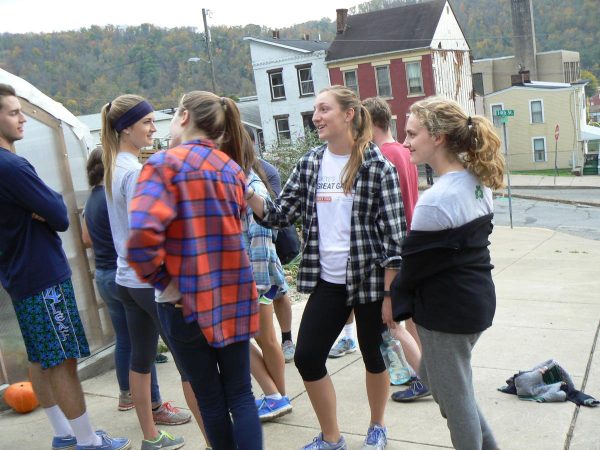
Students from Notre Dame
Caroline Skulski pulled her blonde hair pulled back into a ponytail somewhere on the back of her head. She was relaxed and unassuming. She gave the sense that nothing in life could be that bad. But Caroline cares about food, and she cares about people. She’s a junior at the University of Notre Dame, and she volunteered to be one of the two group leaders in an food justice immersion program in West Virginia.
“My dad’s a doctor so, we had a lot of medical school loans, so for a while, not a comfortable life,” she said. “But then after he was in practice, very comfortable. Definitely coming from a place of privilege, we were pretty lucky.”
The 16 students Skulski was leading had varying educational aspirations, and came from all across the United States. What tied them together, aside from being enrolled at Notre Dame, was that they each decided they would spend their fall break living out of a homeless shelter in Wheeling, W.Va., with a goal of exploring the food issues there. Grow Ohio Valley, a young organization bent on improving the food culture in the area, partnered with Notre Dame to bring students to the area.
“We really want to give the students a hands-on learning experience looking at food economy, the food system, and the problems that there are and potential solutions,” said GrowOV’s director of educational programs, Kate Marshall.
Marshall lives in East Wheeling, where the students stayed for the week. The nearest supermarket is two and a half miles away (a 40- minute walk along roads mostly designed for vehicles).
“This is a food desert, meaning, there is no easily accessible health food and healthy produce within walking distance, and there are only convenient stores to shop at,” Marshall said.
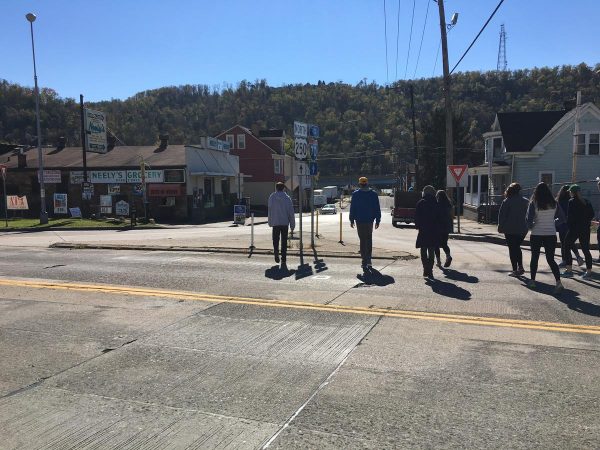
Finding Food
Marshall started the immersion experience off by splitting students into two groups and sending them out onto the urban streets of East Wheeling. 100-year-old, faded Victorian row houses line the once-bustling roads. But today, entire neighborhoods have been torn down. The population has dwindled from 60,000 city residents in it’s heyday in the ’30s and ’40s, to about 27,000 according to the last census.
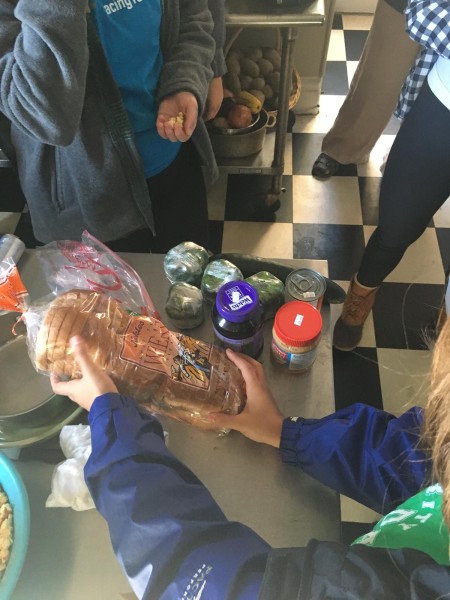
Erin Callaghan, is a sophomore at Notre Dame. Her group headed south with a portion of money in their pockets that was determined by dividing a month’s worth of food stamps into a daily meal’s allowance. In West Virginia that amounts to $1.30.
“We have to be creative in what we can find and what we can eat for lunch,” said Callaghan.
In a different part of town, the other group hit another convenience store. They picked up minute rice, a can of chili, and a dozen eggs.
“I think probably what shocked us the most was that everything there was so expensive. Based on the nutritional value, the cost seemed so unreasonable,” said Sophomore Kathleen Rocks, the other student group leader.
Food for Thought
Lunch provided plenty of food for thought. Marshall pointed out to students that there could be legal barriers to pooling funds because federal dollars are meant for individual families, not groups of people. Marshall also pointed out how good-intending government-funded programs like the Supplemental Nutrition Assistance Program (SNAP) can clash with economic realities:
“Now we have federal dollars that are going to convenience stores that don’t actually support a community but support companies far away that are bringing food into our area that isn’t nutritionally sound and causes health risks to the people eating the food. Then our medical dollars are spent at a higher rate because people are sick.”

Solutions
Exploring systemic issues related to the food economy led students beyond the trappings of convenience stores into abandoned lots that have been reclaimed by Grow Ohio Valley. NAT Students pulled weeds, groomed vegetable beds, and harvested snacks as they learned about possible solutions to the food problems here — things like community gardens, urban farms, mobile food markets, and other efforts GrowOV and community members are engaged in trying to combat food disparities–disparities that often lead the most vulnerable in society to chronic health problems.
To that end, the group visited with healthcare providers like Dr. William Mercer to learn more about the kinds of health issues that ultimately crop up in food deserts.
“I came away more excited than they did just because of their enthusiasm. Here are some young kids who are interested in carrying the torch and hopefully make our society better.”
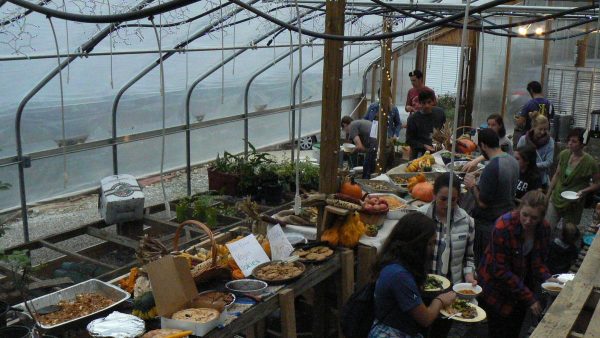
Growing Justice
Grow Ohio Valley’s education program director, Kate Marshall, says students left with new ideas of what “justice” means (and much more interest in growing gardens), but she observed that there was also room to continue to grow their understanding.
She says post evaluations revealed that some students felt perhaps they ate too well during their stay. Marshall disagrees.
“True justice would be making it so that everybody could partake in that same table of plenty and healthful foods, not us eating less and joining the ranks of the unhealthy diet.”
She says the trip was meant to demonstrate the value and potential abundance to be found in local food economies.
“Out of 15 meals,” Marshall said, “we only served meat three times and utilized other protein sources in all our meals. We used over 16 local food sources to provide the bulk of food throughout the week.”
She had to pay a bit more upfront for local homemade breads and jams, but the ability to harvest from the garden provided a drastic reduction in the immersion program food budget (but not, Marshall noted, in the quality of the food).
Marshall says GrowOV plans to continue their immersion programs in spring, summer, and fall breaks. She says she might spend more time in the future talking about economic as well as ethical implications of eating locally. She wants kids, and everyone to realize the impacts of what we choose to eat every day on a community’s health and well-being.
Parting Thoughts
Students stayed during the week in Wheeling at what’s referred to as a Winter Freeze shelter housed in the Youth Services System building in East Wheeling. The shelter is open during the coldest months of the year. It’s the only shelter that will let anyone stay regardless of legal or addiction problems. Marshall asked students to write a letter to the person who will be staying in the bed when the shelter opens later this year.


